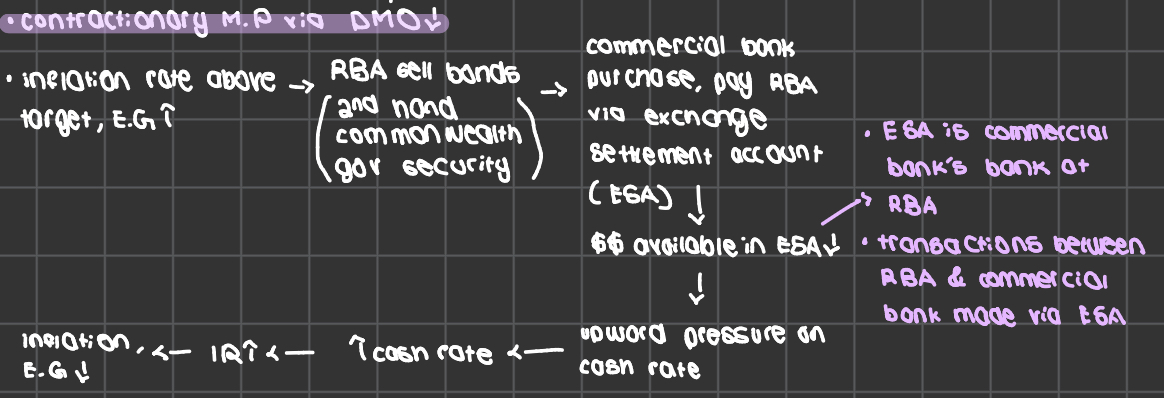Chapter 11 - Monetary Policy
1/17
There's no tags or description
Looks like no tags are added yet.
Name | Mastery | Learn | Test | Matching | Spaced |
|---|
No study sessions yet.
18 Terms
monetary policy
macroeconomic policy that involves action by RBA, on behalf of gov to influence the cost and availability of money and credit in the economy
conducted by RBA
RBA 3 objectives when setting M.P
1) stability of currency
2) maintainence of full employment
3) economic prosperity and welfare
when will RBA implement contractionary M.P?
when inflation is exceeding target
what happens when inflation exceed target?
1) consumer purchasing power falls
price rising faster than their income
2) internatiinal competitiveness falls
worker wage expectation may increase, thus business COP increase, leading to cost push inflation
3) real value on return on investment falls
although ‘number’ same, return on investment can buy less things due to inflation
when will RBA implement expansionary MP?
when inflation lower than target
what happens when inflation lower than target?
1) consumer delay purchases when they expect price to fall
2) downward pressure on price
consumers spend less and business receive less revenue, thus reduce wages
usually, businesses will let wages follow trend of inflation but if inflation already too low, they cant reduce wages anymore, so they lay off workers
conventional MP
action by RBA to influence cash rate through DMO process
cash rate
interest rate set by RBA that banks pay or charge to borrow funds from other banks in overnight market
DMO(domestic market operation) process
when RBA buy/sell bonds to financial insituitions to inject/withdraw cash from financial systems to influence cash rate
contractionary DMO

expansionary DMO

unconventional monetary policy
using tools that dont change interest rate to influence economy
unconventional monetary policy types
forward guidance
asset purchase
term funding facilities
adjustment to market operations
negative interest rate
forward guidance
central bank communicate stance of MP
time based guidance - bank commit to certain MP stance until specific time
stance based guidance - bank commit to a certain MP stance until specific economic condition met
asset purchase
outright purchase of assets by central bank from private sector
injects money into economy, encourage lending and investment
term funding facilities
allow bank to borrow from RBA at lower cost IF bank lower lower IR for borrowers too
adjustment to market operations
provide larger amounts of liquidity to financial system(give banks money)
expand range of accepted collateral
increase range of eligible counterparties they allow to engage in DMO
negative interest rate
people get charged to deposit money into bank